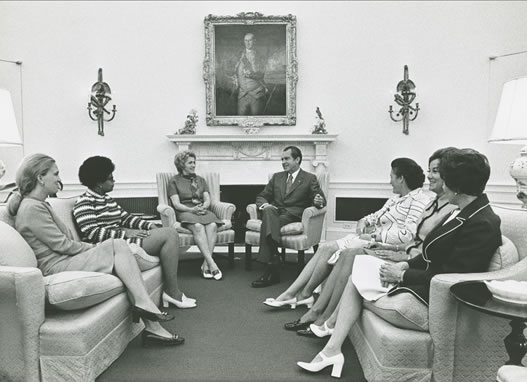- To document through a pilot project how, "a few good women" (and some men) working together on behalf of women generally created a watershed for progress for women in government, and the rest of society, for future generations.
- To utilize oral history as the means of capturing their commitment, tactics, and strategies to achieve goals that were incremental at the time but built a platform for continuing advancement.
- To evaluate the benefits of a larger project that would expand the period studied and increase the number and variety of the oral histories being gathered.

left to right: Barbara Franklin, Sallyanne Payton, Helen Bentley, Richard Nixon, Nancy Hanks, Elizabeth Dole and Ethel Walsh. The White House, August 13, 1971
A little remembered piece of history of the late sixties to mid-seventies was the initiative to recruit and advance women into higher-level government positions. President Richard Nixon first embarked in this direction in a news conference about two weeks after his inauguration. A reporter asked why there had been only three women among the first 200 appointments. President Nixon was unaware of this but promised to correct the imbalance.
Subsequent developments:
- Creation of the Task Force on Women's Rights and Responsibilities, chaired by Virginia Allan, former president of the National Federation of Business and Professional Women's Clubs. Those recommendations all were ultimately adopted. One recommendation urged the creation of a White House Office of Women's Rights and Responsibilities. Another said the President should appoint more women to positions of top responsibility and direct Cabinet and agency heads to give women equal consideration in hiring and promotions.
- Barbara Hackman Franklin named as Staff Assistant to the President with the responsibility for recruitment of women to high-level positions in the Federal Government.
- President asks Cabinet secretaries and agency heads to submit Action Plans describing how they intended to place, recruit, advance and train women in their departments.
- Franklin also is charged with monitoring departmental progress against these plans.
- One year later, in April 1972, the number of women in GS-16 and above, paying $28,000 and up (about $100,000 in today's dollars) had nearly tripled from 36 to 105, many in positions women had never held before. Simultaneously, more than 1,000 women had been hired or promoted to middle management positions. Women became forest rangers, FBI agents, and sky marshals for the first time.
- Logjam of promotions for women in military service broken. Former limit of one female colonel per service put aside, and women promoted for the first time to general to admiral.
- Barriers against women in the Foreign Service lifted.
- Women head Federal Maritime Commission, the Tariff Commission and Atomic Energy Commission for first time.
- Women appointed to the Federal judiciary increased.